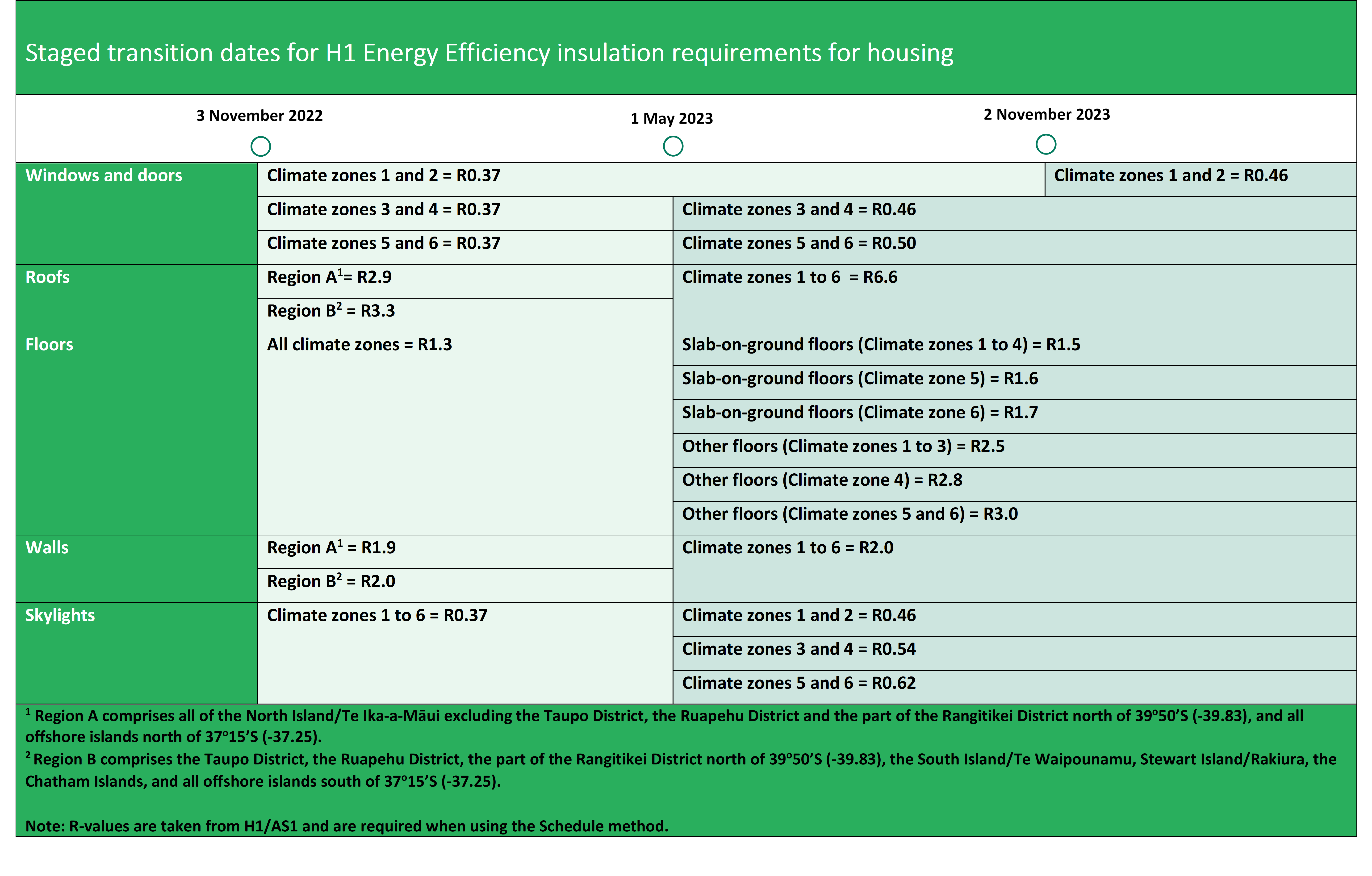Transition period has ended for 2021 updates to the Building Code
Posted: 4 November 2022

This transition period ended on 2 November 2022 and the old documents can now no longer be used. A staged transition of the new insulation requirements for housing has also been provided in the Fifth Edition Amendment 1 versions of H1/AS1 and H1/VM1.
MBIE publishes regular updates to Building Code documents to support Aotearoa New Zealand to deliver safe, healthy and durable buildings. These updates to the building code are published with transition periods which allow the continued use of the existing documents while the sector becomes familiar with the new versions. This provides time to ensure that the changes are implemented smoothly.
You can check the date that a document became effective in the document status section of the relevant acceptable solution or verification method. This section sets out the dates that the most recent version became effective on, and the date that a previous version can be used until. The previous version can be used up to and including the transition end date. After the transition period has ended only the current version can be used as a deemed to comply solution.
The transition period for the 2021 building code updates ended on 2 November 2022. This means that building consent applications submitted on or after 3 November 2022 that use one of the updated acceptable solutions or verification methods as a means of compliance should now use the most recent versions of the documents.
Staged implementation for H1 requirements for housing
Following a public consultation in June 2022, MBIE extended the transition time to comply with new insulation requirements for housing. A staged implementation process for the increased requirements has been provided in the Fifth Edition Amendment 1 versions of H1/AS1 and H1/VM1. There will be an increase to the wall, floor and roof insulation performance requirements for new building work in housing on 1 May 2023. Requirements for window and door insulation in housing also see an increase on 1 May 2023 and will be required to meet the final increased performance levels in all parts of the country by 2 November 2023. The staged requirements are set out in tables within the document, and are shown in the tables below.

Windows and doors
Windows and doors have a mixture of transition dates, with climate zones 3 to 6 changing R-values on 1 May 2023, and climate zones 1 and 2 changing on 2 November 2023.
| Climate zones 1 and 2 = R0.37 | Until 1 November 2023 |
| Climate zones 1 and 2 = R0.46 | On 2 November 2023 |
| Climate zones 3 and 4 = R0.37 | Until 30 April 2023 |
| Climate zones 3 and 4 = R0.46 | On 1 May 2023 |
| Climate zones 5 and 6 = R0.37 | Until 30 April 2023 |
| Climate zones 5 and 6 = R0.50 | On 1 May 2023 |
Floors
All climate zones retain an R-value of R1.3 for floors until 30 April 2023, when they will change depending on climate zone.
| All climate zones = R1.3 | Until 30 April 2023 |
| Slab-on-ground floors (Climate zones 1 to 4) = R1.5 | On 1 May 2023 |
| Slab-on-ground floors (Climate zone 5) = R1.6 | On 1 May 2023 |
| Slab-on-ground floors (Climate zone 6) = R1.7 | On 1 May 2023 |
| Other floors (Climate zones 1 to 3) = R2.5 | On 1 May 2023 |
| Other floors (Climate zone 4) = R2.8 | On 1 May 2023 |
| Other floors (Climate zones 5 and 6) = R3.0 | On 1 May 2023 |
Skylights
All climate zones retain an R-value of R0.37 for skylights up until 30 April 2023, when they will change depending on climate zone.
| Climate zones 1 to 6 = R0.37 | Until 30 April 2023 |
| Climate zones 1 and 2 = R0.46 | On 1 May 2023 |
| Climate zones 3 and 4 = R0.54 | On 1 May 2023 |
| Climate zones 5 and 6 = R0.62 | On 1 May 2023 |
Roofs and walls
Roofs and walls remain separated into two regions (A and B) until 30 April 2023, when the entire country will switch to the same R-values.
Roofs
Region A = R2.9, until 30 April 2023
Region B = R3.3, until 30 April 2023
On 1 May, 2023 all climate zones will move to an R-value of R6.6 for Roofs.
Walls
Region A = R1.9, until 30 April 2023
Region B = R2.0, until 30 April 2023
On 1 May 2023, all climate zones will move to an R-value of R2.0 for walls.
Region A comprises all of the North Island/Te Ika-a-Māui excluding the Taupo District, the Ruapehu District and the part of the Rangitikei District north of 39o50’S (-39.83), and all offshore islands north of 37o15’S (-37.25).
Region B comprises the Taupo District, the Ruapehu District, the part of the Rangitikei District north of 39o50’S (-39.83), the South Island/Te Waipounamu, Stewart Island/Rakiura, the Chatham Islands, and all offshore islands south of 37o15’S (-37.25).